Comparative Analysis of Gender Diversity in the Workplace: A Report
VerifiedAdded on 2023/01/11
|7
|1746
|75
Report
AI Summary
This report provides a comparative analysis of gender diversity in the workplace, drawing insights from two articles. The first article, by Windscheid et al. (2015), examines the discrepancy between organizational needs and employee preferences regarding gender diversity, particularly in leadership roles. The second article, by Dobson, Hensley and Rastad (2017), contrasts the approaches of the European Union (EU), which favors government quotas, and the United States (US), which relies on shareholder resolutions to promote gender diversity on corporate boards. The report highlights the benefits of gender diversity, including diverse viewpoints and optimal human resource utilization, but also acknowledges the challenges posed by societal attitudes and employee perceptions. The analysis suggests that the US approach, which emphasizes shareholder diversity, may be more effective in fostering positive attitudes toward women's employment and ultimately achieving greater gender equality in the workplace. The report concludes that while gender equality is beneficial for business operations, negative social attitudes remain a key obstacle and recommends strategies for managing diversity and mitigating employee resistance.
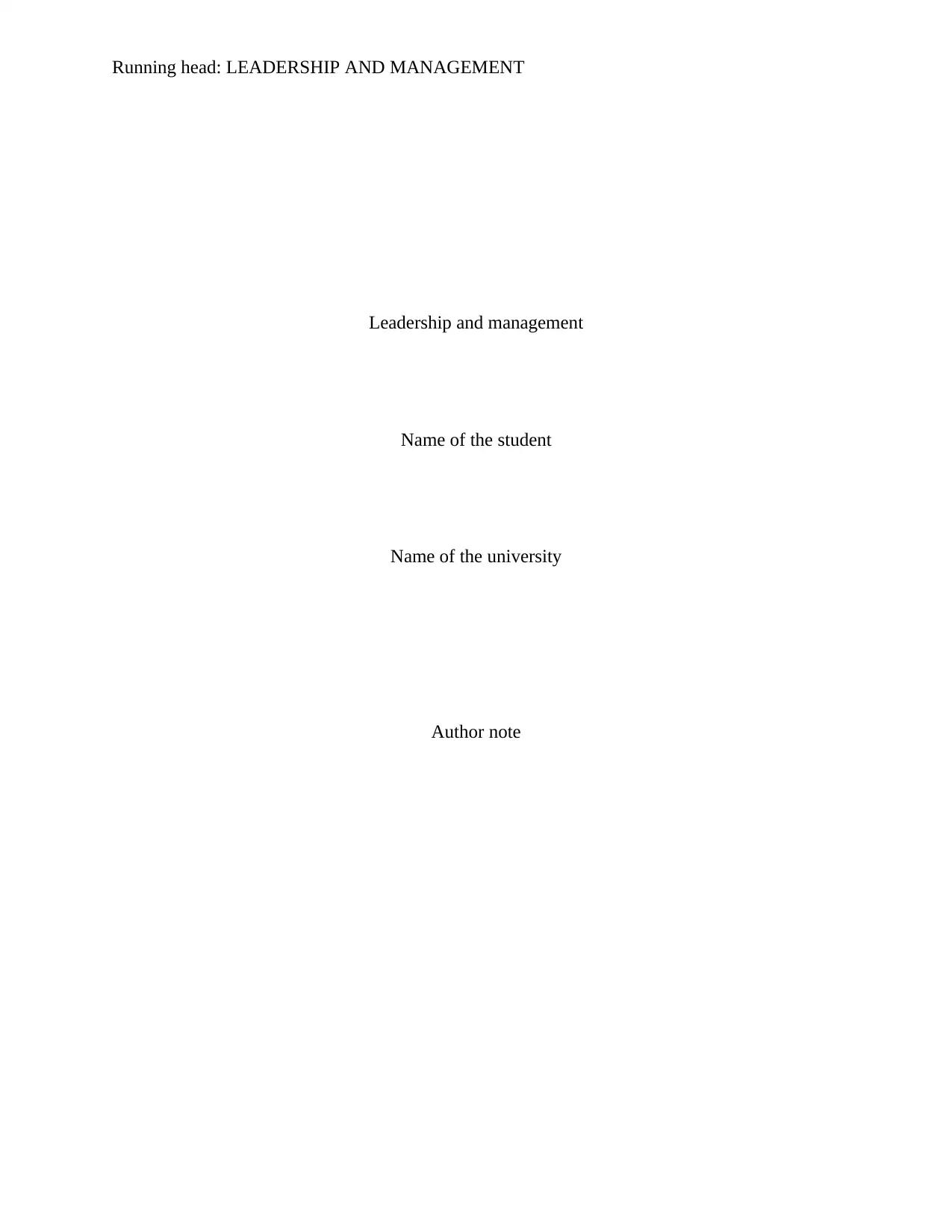
Running head: LEADERSHIP AND MANAGEMENT
Leadership and management
Name of the student
Name of the university
Author note
Leadership and management
Name of the student
Name of the university
Author note
Paraphrase This Document
Need a fresh take? Get an instant paraphrase of this document with our AI Paraphraser
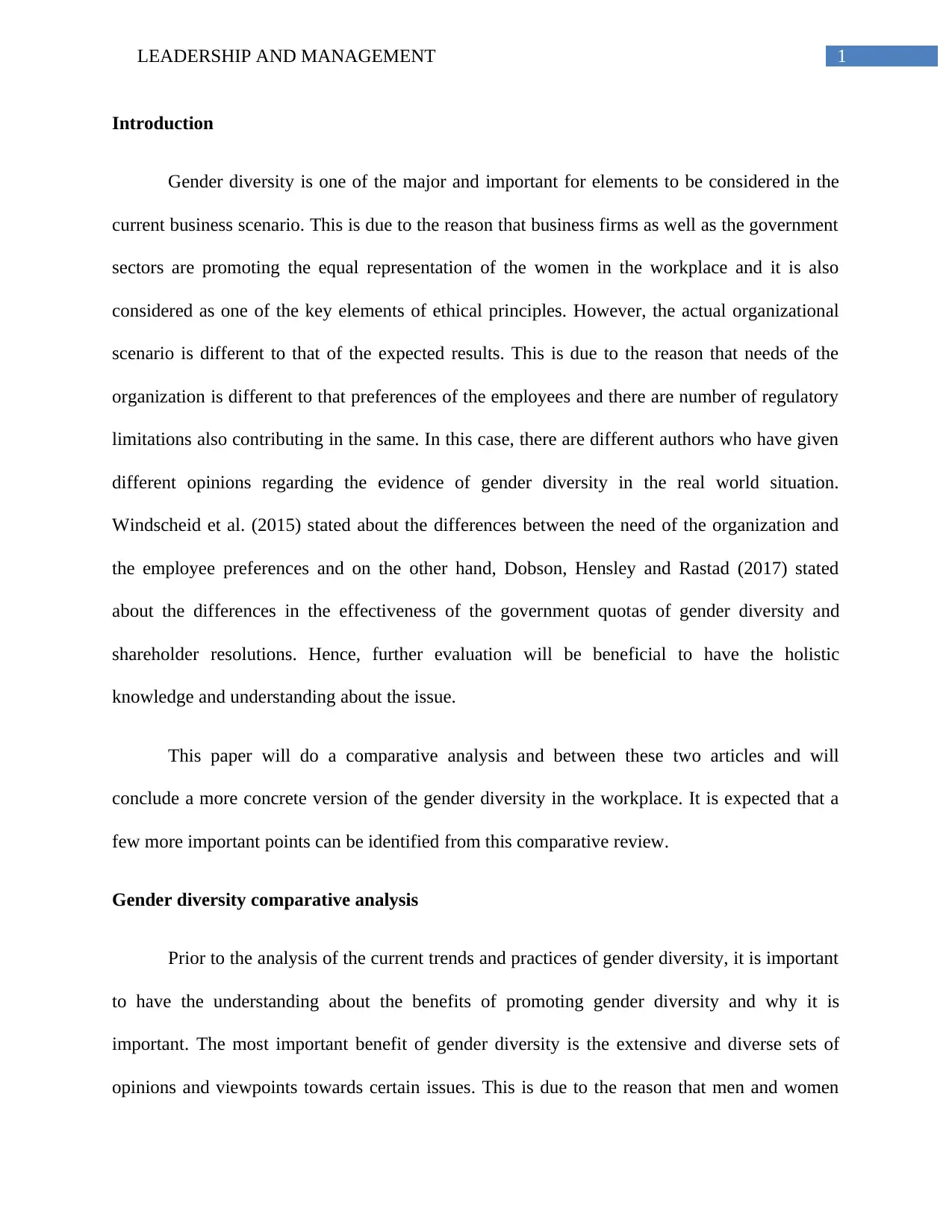
1LEADERSHIP AND MANAGEMENT
Introduction
Gender diversity is one of the major and important for elements to be considered in the
current business scenario. This is due to the reason that business firms as well as the government
sectors are promoting the equal representation of the women in the workplace and it is also
considered as one of the key elements of ethical principles. However, the actual organizational
scenario is different to that of the expected results. This is due to the reason that needs of the
organization is different to that preferences of the employees and there are number of regulatory
limitations also contributing in the same. In this case, there are different authors who have given
different opinions regarding the evidence of gender diversity in the real world situation.
Windscheid et al. (2015) stated about the differences between the need of the organization and
the employee preferences and on the other hand, Dobson, Hensley and Rastad (2017) stated
about the differences in the effectiveness of the government quotas of gender diversity and
shareholder resolutions. Hence, further evaluation will be beneficial to have the holistic
knowledge and understanding about the issue.
This paper will do a comparative analysis and between these two articles and will
conclude a more concrete version of the gender diversity in the workplace. It is expected that a
few more important points can be identified from this comparative review.
Gender diversity comparative analysis
Prior to the analysis of the current trends and practices of gender diversity, it is important
to have the understanding about the benefits of promoting gender diversity and why it is
important. The most important benefit of gender diversity is the extensive and diverse sets of
opinions and viewpoints towards certain issues. This is due to the reason that men and women
Introduction
Gender diversity is one of the major and important for elements to be considered in the
current business scenario. This is due to the reason that business firms as well as the government
sectors are promoting the equal representation of the women in the workplace and it is also
considered as one of the key elements of ethical principles. However, the actual organizational
scenario is different to that of the expected results. This is due to the reason that needs of the
organization is different to that preferences of the employees and there are number of regulatory
limitations also contributing in the same. In this case, there are different authors who have given
different opinions regarding the evidence of gender diversity in the real world situation.
Windscheid et al. (2015) stated about the differences between the need of the organization and
the employee preferences and on the other hand, Dobson, Hensley and Rastad (2017) stated
about the differences in the effectiveness of the government quotas of gender diversity and
shareholder resolutions. Hence, further evaluation will be beneficial to have the holistic
knowledge and understanding about the issue.
This paper will do a comparative analysis and between these two articles and will
conclude a more concrete version of the gender diversity in the workplace. It is expected that a
few more important points can be identified from this comparative review.
Gender diversity comparative analysis
Prior to the analysis of the current trends and practices of gender diversity, it is important
to have the understanding about the benefits of promoting gender diversity and why it is
important. The most important benefit of gender diversity is the extensive and diverse sets of
opinions and viewpoints towards certain issues. This is due to the reason that men and women
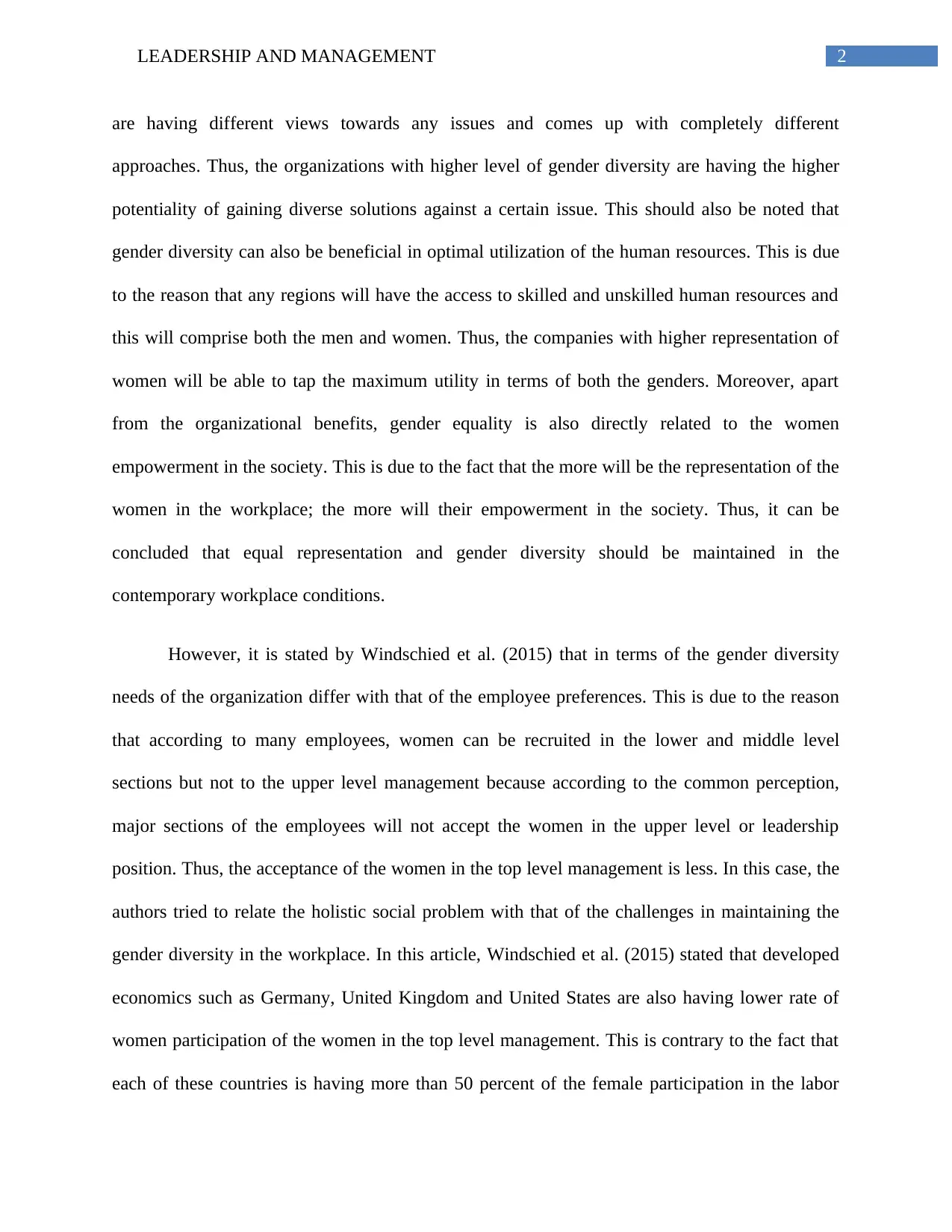
2LEADERSHIP AND MANAGEMENT
are having different views towards any issues and comes up with completely different
approaches. Thus, the organizations with higher level of gender diversity are having the higher
potentiality of gaining diverse solutions against a certain issue. This should also be noted that
gender diversity can also be beneficial in optimal utilization of the human resources. This is due
to the reason that any regions will have the access to skilled and unskilled human resources and
this will comprise both the men and women. Thus, the companies with higher representation of
women will be able to tap the maximum utility in terms of both the genders. Moreover, apart
from the organizational benefits, gender equality is also directly related to the women
empowerment in the society. This is due to the fact that the more will be the representation of the
women in the workplace; the more will their empowerment in the society. Thus, it can be
concluded that equal representation and gender diversity should be maintained in the
contemporary workplace conditions.
However, it is stated by Windschied et al. (2015) that in terms of the gender diversity
needs of the organization differ with that of the employee preferences. This is due to the reason
that according to many employees, women can be recruited in the lower and middle level
sections but not to the upper level management because according to the common perception,
major sections of the employees will not accept the women in the upper level or leadership
position. Thus, the acceptance of the women in the top level management is less. In this case, the
authors tried to relate the holistic social problem with that of the challenges in maintaining the
gender diversity in the workplace. In this article, Windschied et al. (2015) stated that developed
economics such as Germany, United Kingdom and United States are also having lower rate of
women participation of the women in the top level management. This is contrary to the fact that
each of these countries is having more than 50 percent of the female participation in the labor
are having different views towards any issues and comes up with completely different
approaches. Thus, the organizations with higher level of gender diversity are having the higher
potentiality of gaining diverse solutions against a certain issue. This should also be noted that
gender diversity can also be beneficial in optimal utilization of the human resources. This is due
to the reason that any regions will have the access to skilled and unskilled human resources and
this will comprise both the men and women. Thus, the companies with higher representation of
women will be able to tap the maximum utility in terms of both the genders. Moreover, apart
from the organizational benefits, gender equality is also directly related to the women
empowerment in the society. This is due to the fact that the more will be the representation of the
women in the workplace; the more will their empowerment in the society. Thus, it can be
concluded that equal representation and gender diversity should be maintained in the
contemporary workplace conditions.
However, it is stated by Windschied et al. (2015) that in terms of the gender diversity
needs of the organization differ with that of the employee preferences. This is due to the reason
that according to many employees, women can be recruited in the lower and middle level
sections but not to the upper level management because according to the common perception,
major sections of the employees will not accept the women in the upper level or leadership
position. Thus, the acceptance of the women in the top level management is less. In this case, the
authors tried to relate the holistic social problem with that of the challenges in maintaining the
gender diversity in the workplace. In this article, Windschied et al. (2015) stated that developed
economics such as Germany, United Kingdom and United States are also having lower rate of
women participation of the women in the top level management. This is contrary to the fact that
each of these countries is having more than 50 percent of the female participation in the labor
⊘ This is a preview!⊘
Do you want full access?
Subscribe today to unlock all pages.

Trusted by 1+ million students worldwide
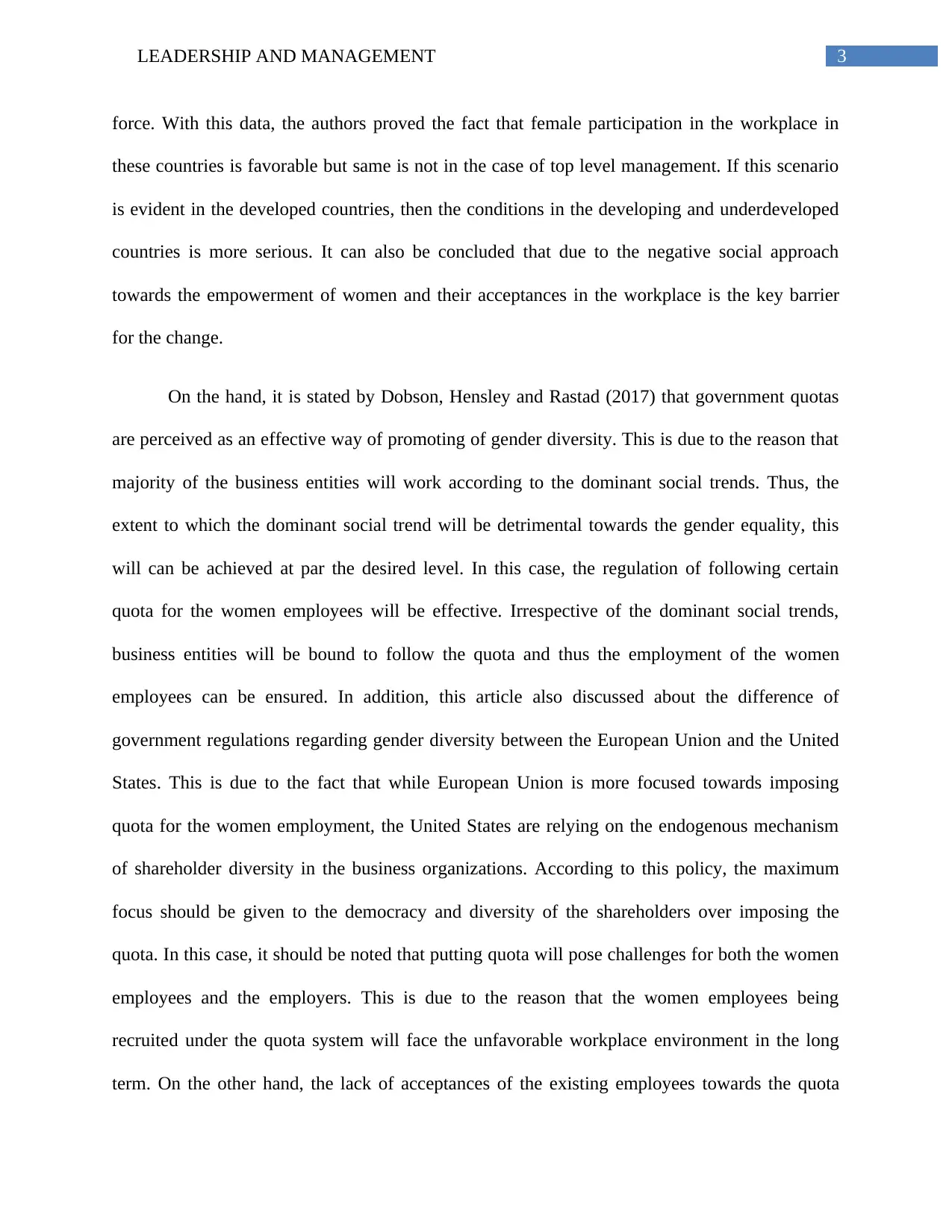
3LEADERSHIP AND MANAGEMENT
force. With this data, the authors proved the fact that female participation in the workplace in
these countries is favorable but same is not in the case of top level management. If this scenario
is evident in the developed countries, then the conditions in the developing and underdeveloped
countries is more serious. It can also be concluded that due to the negative social approach
towards the empowerment of women and their acceptances in the workplace is the key barrier
for the change.
On the hand, it is stated by Dobson, Hensley and Rastad (2017) that government quotas
are perceived as an effective way of promoting of gender diversity. This is due to the reason that
majority of the business entities will work according to the dominant social trends. Thus, the
extent to which the dominant social trend will be detrimental towards the gender equality, this
will can be achieved at par the desired level. In this case, the regulation of following certain
quota for the women employees will be effective. Irrespective of the dominant social trends,
business entities will be bound to follow the quota and thus the employment of the women
employees can be ensured. In addition, this article also discussed about the difference of
government regulations regarding gender diversity between the European Union and the United
States. This is due to the fact that while European Union is more focused towards imposing
quota for the women employment, the United States are relying on the endogenous mechanism
of shareholder diversity in the business organizations. According to this policy, the maximum
focus should be given to the democracy and diversity of the shareholders over imposing the
quota. In this case, it should be noted that putting quota will pose challenges for both the women
employees and the employers. This is due to the reason that the women employees being
recruited under the quota system will face the unfavorable workplace environment in the long
term. On the other hand, the lack of acceptances of the existing employees towards the quota
force. With this data, the authors proved the fact that female participation in the workplace in
these countries is favorable but same is not in the case of top level management. If this scenario
is evident in the developed countries, then the conditions in the developing and underdeveloped
countries is more serious. It can also be concluded that due to the negative social approach
towards the empowerment of women and their acceptances in the workplace is the key barrier
for the change.
On the hand, it is stated by Dobson, Hensley and Rastad (2017) that government quotas
are perceived as an effective way of promoting of gender diversity. This is due to the reason that
majority of the business entities will work according to the dominant social trends. Thus, the
extent to which the dominant social trend will be detrimental towards the gender equality, this
will can be achieved at par the desired level. In this case, the regulation of following certain
quota for the women employees will be effective. Irrespective of the dominant social trends,
business entities will be bound to follow the quota and thus the employment of the women
employees can be ensured. In addition, this article also discussed about the difference of
government regulations regarding gender diversity between the European Union and the United
States. This is due to the fact that while European Union is more focused towards imposing
quota for the women employment, the United States are relying on the endogenous mechanism
of shareholder diversity in the business organizations. According to this policy, the maximum
focus should be given to the democracy and diversity of the shareholders over imposing the
quota. In this case, it should be noted that putting quota will pose challenges for both the women
employees and the employers. This is due to the reason that the women employees being
recruited under the quota system will face the unfavorable workplace environment in the long
term. On the other hand, the lack of acceptances of the existing employees towards the quota
Paraphrase This Document
Need a fresh take? Get an instant paraphrase of this document with our AI Paraphraser
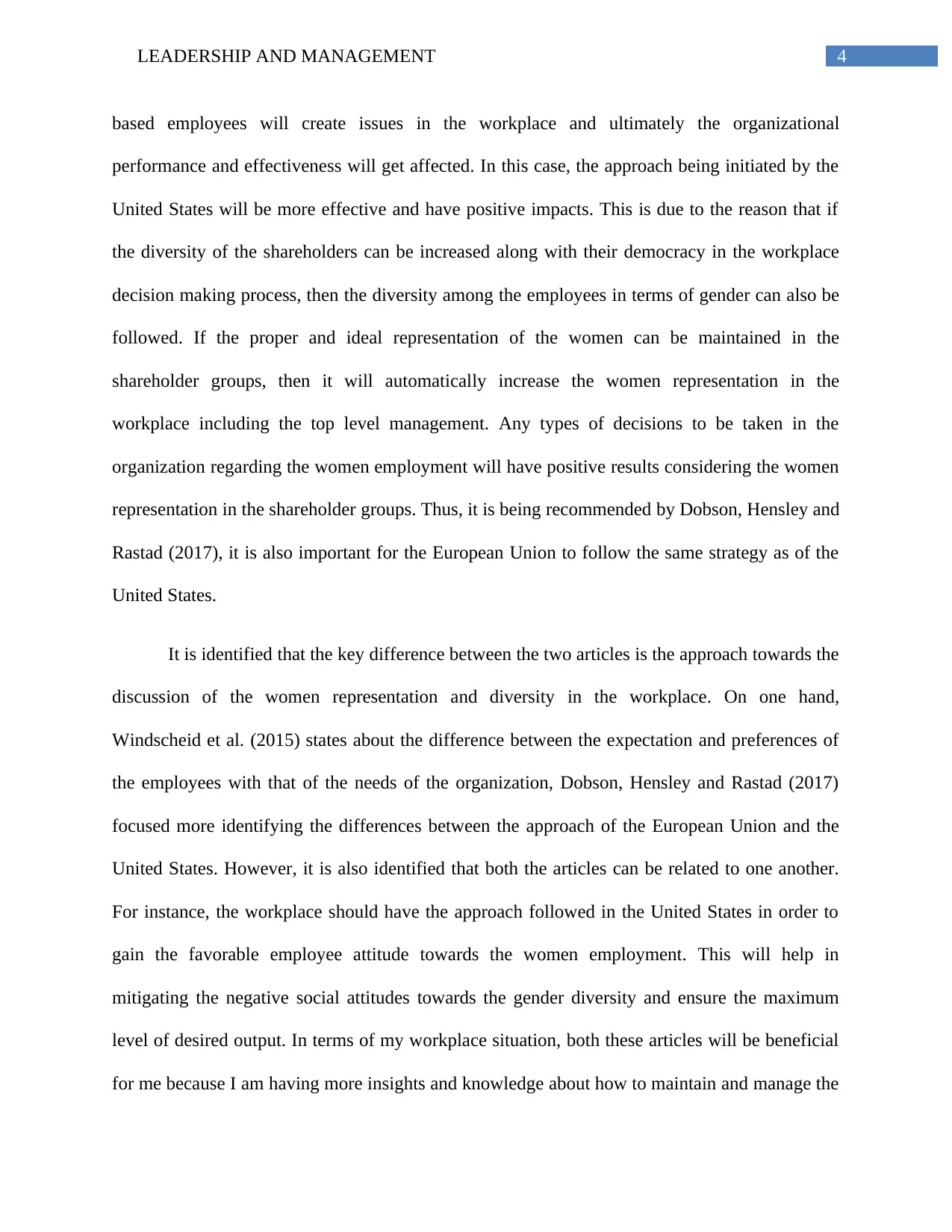
4LEADERSHIP AND MANAGEMENT
based employees will create issues in the workplace and ultimately the organizational
performance and effectiveness will get affected. In this case, the approach being initiated by the
United States will be more effective and have positive impacts. This is due to the reason that if
the diversity of the shareholders can be increased along with their democracy in the workplace
decision making process, then the diversity among the employees in terms of gender can also be
followed. If the proper and ideal representation of the women can be maintained in the
shareholder groups, then it will automatically increase the women representation in the
workplace including the top level management. Any types of decisions to be taken in the
organization regarding the women employment will have positive results considering the women
representation in the shareholder groups. Thus, it is being recommended by Dobson, Hensley and
Rastad (2017), it is also important for the European Union to follow the same strategy as of the
United States.
It is identified that the key difference between the two articles is the approach towards the
discussion of the women representation and diversity in the workplace. On one hand,
Windscheid et al. (2015) states about the difference between the expectation and preferences of
the employees with that of the needs of the organization, Dobson, Hensley and Rastad (2017)
focused more identifying the differences between the approach of the European Union and the
United States. However, it is also identified that both the articles can be related to one another.
For instance, the workplace should have the approach followed in the United States in order to
gain the favorable employee attitude towards the women employment. This will help in
mitigating the negative social attitudes towards the gender diversity and ensure the maximum
level of desired output. In terms of my workplace situation, both these articles will be beneficial
for me because I am having more insights and knowledge about how to maintain and manage the
based employees will create issues in the workplace and ultimately the organizational
performance and effectiveness will get affected. In this case, the approach being initiated by the
United States will be more effective and have positive impacts. This is due to the reason that if
the diversity of the shareholders can be increased along with their democracy in the workplace
decision making process, then the diversity among the employees in terms of gender can also be
followed. If the proper and ideal representation of the women can be maintained in the
shareholder groups, then it will automatically increase the women representation in the
workplace including the top level management. Any types of decisions to be taken in the
organization regarding the women employment will have positive results considering the women
representation in the shareholder groups. Thus, it is being recommended by Dobson, Hensley and
Rastad (2017), it is also important for the European Union to follow the same strategy as of the
United States.
It is identified that the key difference between the two articles is the approach towards the
discussion of the women representation and diversity in the workplace. On one hand,
Windscheid et al. (2015) states about the difference between the expectation and preferences of
the employees with that of the needs of the organization, Dobson, Hensley and Rastad (2017)
focused more identifying the differences between the approach of the European Union and the
United States. However, it is also identified that both the articles can be related to one another.
For instance, the workplace should have the approach followed in the United States in order to
gain the favorable employee attitude towards the women employment. This will help in
mitigating the negative social attitudes towards the gender diversity and ensure the maximum
level of desired output. In terms of my workplace situation, both these articles will be beneficial
for me because I am having more insights and knowledge about how to maintain and manage the
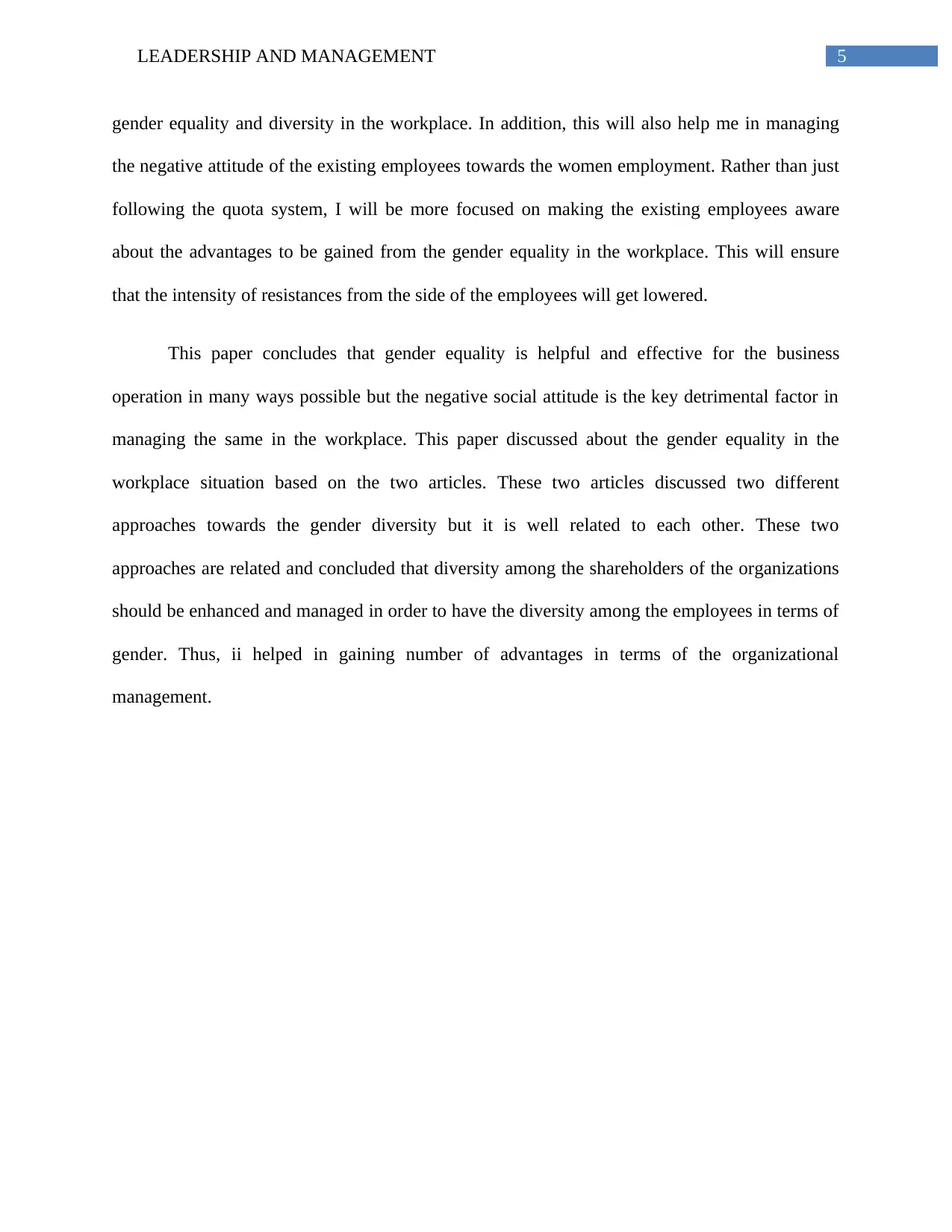
5LEADERSHIP AND MANAGEMENT
gender equality and diversity in the workplace. In addition, this will also help me in managing
the negative attitude of the existing employees towards the women employment. Rather than just
following the quota system, I will be more focused on making the existing employees aware
about the advantages to be gained from the gender equality in the workplace. This will ensure
that the intensity of resistances from the side of the employees will get lowered.
This paper concludes that gender equality is helpful and effective for the business
operation in many ways possible but the negative social attitude is the key detrimental factor in
managing the same in the workplace. This paper discussed about the gender equality in the
workplace situation based on the two articles. These two articles discussed two different
approaches towards the gender diversity but it is well related to each other. These two
approaches are related and concluded that diversity among the shareholders of the organizations
should be enhanced and managed in order to have the diversity among the employees in terms of
gender. Thus, ii helped in gaining number of advantages in terms of the organizational
management.
gender equality and diversity in the workplace. In addition, this will also help me in managing
the negative attitude of the existing employees towards the women employment. Rather than just
following the quota system, I will be more focused on making the existing employees aware
about the advantages to be gained from the gender equality in the workplace. This will ensure
that the intensity of resistances from the side of the employees will get lowered.
This paper concludes that gender equality is helpful and effective for the business
operation in many ways possible but the negative social attitude is the key detrimental factor in
managing the same in the workplace. This paper discussed about the gender equality in the
workplace situation based on the two articles. These two articles discussed two different
approaches towards the gender diversity but it is well related to each other. These two
approaches are related and concluded that diversity among the shareholders of the organizations
should be enhanced and managed in order to have the diversity among the employees in terms of
gender. Thus, ii helped in gaining number of advantages in terms of the organizational
management.
⊘ This is a preview!⊘
Do you want full access?
Subscribe today to unlock all pages.

Trusted by 1+ million students worldwide
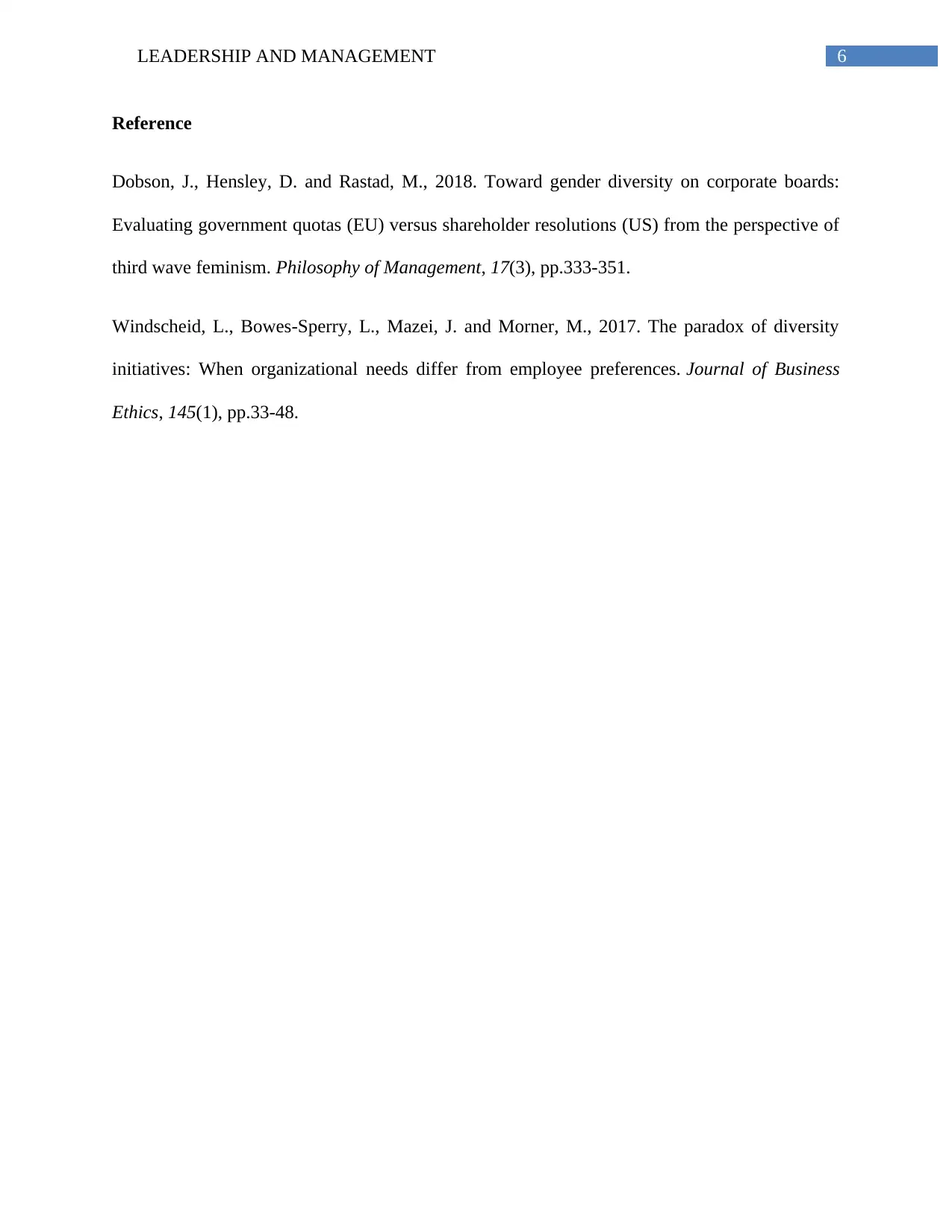
6LEADERSHIP AND MANAGEMENT
Reference
Dobson, J., Hensley, D. and Rastad, M., 2018. Toward gender diversity on corporate boards:
Evaluating government quotas (EU) versus shareholder resolutions (US) from the perspective of
third wave feminism. Philosophy of Management, 17(3), pp.333-351.
Windscheid, L., Bowes-Sperry, L., Mazei, J. and Morner, M., 2017. The paradox of diversity
initiatives: When organizational needs differ from employee preferences. Journal of Business
Ethics, 145(1), pp.33-48.
Reference
Dobson, J., Hensley, D. and Rastad, M., 2018. Toward gender diversity on corporate boards:
Evaluating government quotas (EU) versus shareholder resolutions (US) from the perspective of
third wave feminism. Philosophy of Management, 17(3), pp.333-351.
Windscheid, L., Bowes-Sperry, L., Mazei, J. and Morner, M., 2017. The paradox of diversity
initiatives: When organizational needs differ from employee preferences. Journal of Business
Ethics, 145(1), pp.33-48.
1 out of 7
Related Documents
Your All-in-One AI-Powered Toolkit for Academic Success.
+13062052269
info@desklib.com
Available 24*7 on WhatsApp / Email
![[object Object]](/_next/static/media/star-bottom.7253800d.svg)
Unlock your academic potential
Copyright © 2020–2025 A2Z Services. All Rights Reserved. Developed and managed by ZUCOL.





